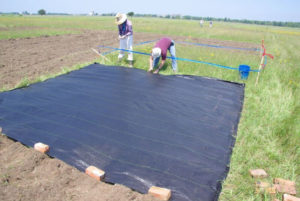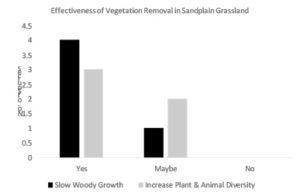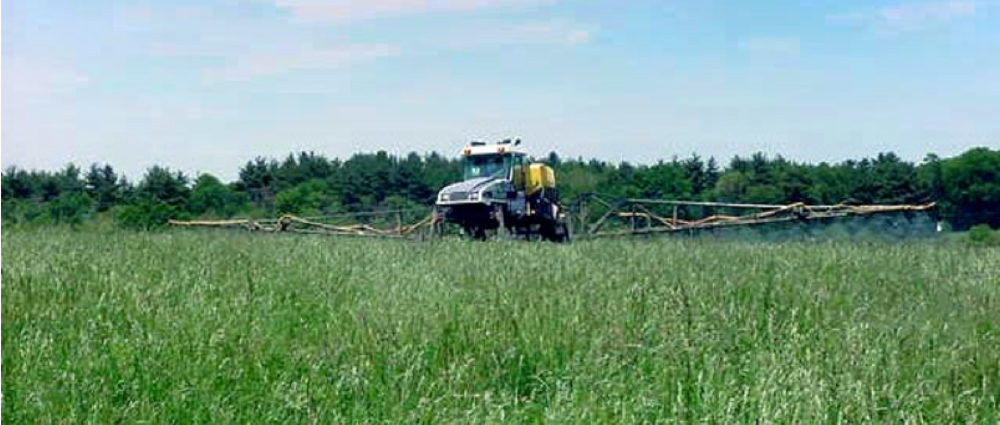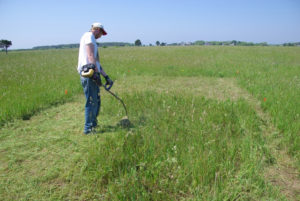Vegetation Removal in Existing Grassland
Removal of select plants or communities can be used to maintain disturbance-adapted sandplain grassland by manipulating ecological succession. The principal goals of management with vegetation removal are to reduce woody vegetation cover, create conditions that maintain plant and animal species that rely on grassland habitat, and promote recruitment and establishment of native grassland species.

Figure 1. Invasive grass removal using plastic covering at the Bamford Preserve, Martha’s Vineyard. Photo: Chris Neill
Vegetation removal activities in sandplain grassland typically aim to promote a diverse assemblage of target grassland species with a high proportion of warm-season grasses and native forbs, and a low proportion of cool season grasses and nonnative invasive species through the removal of undesirable species. In existing grassland, undesirable species include nonnative and aggressive native and non-native woody plants. Vegetation removal can be mechanical such as hand-pulling, digging, cutting, select mowing, or shading (Fig. 1). It can be by chemical treatment with herbicides, or by a combination of mechanical and chemical methods. The most commonly used and effective method is direct herbicide application to undesirable species. Recent experience shows that this can be an effective, targeted tool to remove unwanted plants from existing sandplain grasslands.
In this document, we evaluate the effects of vegetation removal management techniques in sandplain grassland compiled from published and unpublished studies and information obtained from interviews with land managers. We focused on the following main questions relevant for sandplain grassland management:
- Does vegetation removal reduce woody growth?
- Does vegetation removal maintain or increase grassland associated plant and animal species diversity?
- Under which conditions is vegetation removal more or less effective at reducing woody species cover?
- How can the effectiveness of vegetation removal be improved as a management tool to maintain sandplain grassland?
We focus on interpreting the main patterns that emerge from examining multiple experiences across multiple sites, with the understanding that responses in any one vegetation removal treatment under particular conditions may differ.
Methods

Figure 2. A small number of sources found that selective removal of vegetation in sandplain grasslands slowed growth of woody species and increased plant and animal diversity.
We reviewed 75 sources that described or documented results of management actions in sandplain grassland. Of these, only seven sources contained information on vegetation removal and one detailed a specific management experiment. In addition, we interviewed nine professionals throughout the region about their experiences with prescribed vegetation removal in sandplain grassland (Fig. 2).
This review and interviews is used to summarize the state of current management understanding using vegetation removal in sandplain grassland and the effects of vegetation removal on: (1) vegetation composition, (2) vegetation structure, and (3) fauna in relation to different techniques. We then suggest ways that the use of vegetation removal could be improved to decrease woody cover, increase graminoid cover, and maintain and promote biodiversity in sandplain grassland.
Four sources highlight that vegetation removal can decrease woody growth and/or increase plant and animal diversity (Dunwiddie n.d., Raleigh et al. 2003, Ecological management of grasslands 2009, and Wheeler et al. 2015). More work is needed to understand vegetation removal and its effects on sandplain grasslands, especially in relation to individual responses of target species.
The primary goal of vegetation removal in sandplain grassland is to control woody species and non-native invasive vegetation growth, which can compete with desired sandplain grassland species. Vegetation removal has the ability to target specific individual plants or potentially larger patches of individual plants. Vegetation removal is intended to quickly and efficiently remove undesirable vegetation to allow desirable vegetation a chance to establish and is not considered a management technique that will be utilized long term. Vegetation removal can also be applied mechanically by hand digging or pulling of target species prior to seed set. This can be both time- and labor-intensive and often depends on the availability of staff and/or volunteers. Manual pulling can also disturb the soil and surrounding native plants (D. Vitz, Interview). Other methods of vegetation removal include mowing, flooding, grazing, smothering, and hot foam application. Mechanical methods are often used prior to the application of herbicide.
The undesirable consequences of herbicide for sandplain grassland vegetation include mistakenly killing native desirable plant species, potential negative effects on animals such as insects, and negative effects on soils. Use of herbicides faces few technical constraints that would hinder or prevent its use, but public objections to its use often arise. Temperature, wind, and improper application can cause undesirable consequences, and training is required to maximize its effectiveness. Experiences of managers with herbicide and carefully planned experimental herbicide treatments during the last several decades provide information on herbicide effects in sandplain grasslands.
Logistical and Practical Constraints on the Use of Vegetation Removal
Historically there has been concern about the use of herbicides, particularly regionally in coastal Massachusetts (J. McCumber, Interview). In the past, public opinion has limited the use of herbicides in grassland maintenance, especially to control native and non-native invasive species (P. Dunwiddie, Interview). Public concerns about chemical herbicides are focused on potential environmental impacts on non-target plants and animals.
Training and licensure is required to apply herbicide at the management level and managers with experience with herbicides in sandplain grasslands make a number of the following recommendations for safe herbicide use. While most modern herbicides are not typically toxic to non-target plants, wildlife, or humans when used appropriately (Raleigh et al. 2003, P. Dunwiddie, Interview), restrictions for specific chemicals need to be followed. For example, Krenite application should not be applied to standing water, but should be applied directly to brushy plants typically by ground sprayers. Glyphosate should not be applied near surface waters or to bare soil. Herbicides that are not problematic for groundwater or soil should be chosen for managing sandplain grassland (J. McCumber, Interview).
Impacts of herbicides to non-target species can be reduced by adjusting application methods. Broadcast spray from airplane or tractor can be useful but also raises the most concerns. For example, at Westover Air Force Base in Chicopee, Massachusetts, both aerial and boom spray techniques (Fig. 4) were used in one of the largest and most successful grassland restoration projects in the northeast. But application of herbicides by broadcast spraying has been identified by other managers as potentially most problematic because of effects on insect populations (TTOR 2009), and others suggest that selected spot treatment is safer (G. Motzkin, Interview).
One of the most localized methods for herbicide application is mechanical cutting and painting of herbicide on stems. In addition, foliar spray can be applied with equipment that sprays individual plants (Drew Vitz, Interview). Such targeted application methods reduce the impacts of herbicide on other plants or animals (J. McCumber, Interview). The weather conditions when herbicides are applied should be carefully considered (Raleigh et al. 2003).

Figure 4. An example boom-broadcast of herbicide for conversion from agricultural lands to exclude perennial grasses. Credit: Paul Rothbart, Connecticut Department of Environmental Protection.
Although removing vegetation during particular times of stress such as during droughts or outbreaks of herbivorous insects could increase its effectiveness and reduce the frequency of management required to obtain similar vegetation responses, being able to take advantage of these events in particular places will likely be challenging.
Hand pulling and cutting are typically limited by a combination of the large amount of labor required to treat large areas, the ineffectiveness of hand removal in completely removing plants and rootstocks, and the frequency with which hand treatments need to be repeated.
Summary and Pathways to More Effective Management
Experience of sandplain grassland mangers shows that applications of herbicides have been effective to reduce non-native invasive species and increase diversity and cover of native target species in sandplain grasslands.
Research on the effects of herbicides on vegetation, fauna, and soils in sandplain grasslands is nearly non-existent. Although herbicide and other vegetation removal techniques are commonly used there has been no research related to the specific response of target species in relation to specific herbicides, timing and frequency of application or combinations of mechanical and chemical application. In addition, no research has examined effects on non-target sandplain grassland plant species, fauna, or soils.
This review identified several major ways to improve understanding and the potential benefits of the use of vegetation removal for sandplain grassland management.
(1) Test combinations of use of herbicides in combination with other practices to control woody vegetation and non-native invasive species. Tests should be designed and monitored as field experiments, and ideally applied in sub-plots that receive other forms of management within larger areas that receive regular prescribed fire, mowing, and/or grazing.
(2) Improve understanding of how infrequent or rare plants respond to different vegetation removal combinations. These rarer plants are some of the major targets for sandplain grassland management and often have life history characteristics that differ from closely-related but more common species, and could be sensitive to timing, frequency and chemical differences of herbicide treatments. There is currently almost no information on how these species respond to vegetation removal and the effects of these treatments to non-target species.
(3) More work is needed to determine how prescribed vegetation removal affects the mortality and population dynamics of fauna in sandplain grassland. These effects may be particularly important for less common and conservation target species that have small and dispersed populations. It is also important for uncommon species of grassland birds and for more common species such as some invertebrates that are important prey species.
References
Raleigh, L., Capece, J., & Berry, A. 2003. Sand barrens habitat management: A toolbox for managers. Vineyard Haven, MA. Report, unpublished.
The Trustees of Reservations (TTOR). 2009. Ecological management of grasslands: Guidelines for managers. Internal report to The Trustees of Reservations, unpublished.
Wheeler, M.M., Neill, C., Loucks, E., Weiler, A., Von Holle, B., Pelikan, M., & Chase, T. 2015. Vegetation removal and seed addition contribute to coastal sandplain grassland establishment on former agricultural fields. Restoration Ecology 23: 539–547.
Other Sources
Buelow, Chris. Interview by Lena Champlin. November 20, 2016.
Dunwiddie, Peter. Interview by Lena Champlin. November 14, 2016.
Karberg, Jennifer. Interviewed by Lena Champlin. Unknown date.
McCumber, Jake. Interview by Lena Champlin. November 10, 2016.
Motzkin, Glenn. Interviewed by Lena Champlin. Unknown date
Neill, Chris. Interview by Lena Champlin. November 2, 2016.
Polatin, Chris. Interview by Lena Champlin. January 8, 2017.
Scanlon, John. Interviewed by Lena Champlin. November 20, 2016.
Vitz, Drew. Interview by Lena Champlin. November 20, 2016.



